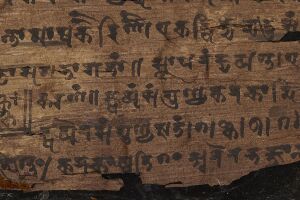Ancient Indian History
Alexander Cunningham[1] writes that ....From the accounts of the Greeks it would appear that the ancient Indians had a very accurate knowledge of the true shape and size of their country. According to Strabo,[2] Alexander " caused the whole country to be described by men well acquainted with it ;" and this account was afterwards lent to Patrokles by Xenokles, the treasurer of the Syrian kings. Patrokles himself held the government of the north-east satrapies of the Syrian empire under Seleukus Nikator and Antiochus Soter, and the information which he collected regarding India and the Eastern provinces, has received the approbation of Eratosthenes and Strabo for its accuracy. Another account of India was derived from the register of the Stathmi,[3] or "Marches" from place to place, which was prepared by the Macedonian
Earliest use of Zero in Ancient Indian texts
Reference - Timothy Revell in Times of India 15.9.2017
The symbol "0" is a familiar sight, but its origins are far from certain. A recent batch of carbon dating is causing the history of mathematics to be rewritten, as it has discovered zeros dating back to a period 500 years before previously seen.
The numbers appear in an ancient Indian text called the Bakhshali manuscript, which consists of 70 leaves of birch bark, filled with mathematics and text in the form of Sanskrit. "It seems to be a training manual for Buddhist monks," says Marcus du Sautoy at the University of Oxford.
The manuscript was first discovered by a local farmer in 1881, and was named after the village it was found in, in what is now Pakistan. It's been housed by the University of Oxford's Bodleian Library since 1902.
Now, the manuscript has been carbon dated -and this has immediately upturned commonly held beliefs. It was originally thought that the manuscript was from the 9th century, but the dating methods revealed that the oldest pages are from somewhere between 224 AD and 383 AD. This means that the manuscript predates a 9th century inscription of zero on the wall of a temple in Gwalior, India, which was previously considered to be the oldest recorded example of a zero.
Across the text there are hundreds of zeros denoted using a dot. It's this dot that later evolved to be the symbol with a hole in the middle that we know today. The dot was originally used as a placeholder, like how "0" is used in the number 505 to denote that there are no tens, but was not yet a number in its own right. The use of zero as a placeholder appeared in several different ancient cultures, such as the ancient Mayans and Babylonians. But only the Indian dot would eventually go on to gain true number status, first described in 628 AD by the Indian astronomer and mathematician Brahmagupta.
"Some of these ideas that we take for granted had to be dreamt up. Numbers were there to count things, so if there is nothing there why would you need a number?" says du Sautoy. The concept of zero, initially banned as heresy, was eventually allowed for the development of calculus, and underpins the digital age. "The whole of modern technology is built on the idea of something and nothing," he says.
Gwalior Inscription of 876 CE
The first inscription showing the use of zero which is dated and is not disputed by any historian is the stone inscription found at the Chaturbhuja Temple at Gwalior dated 933 in the Vikrama calendar (876 CE.), where 50 garlands are mentioned (line 20), here 50 and 270 are written with zero.[4]
See also
References
- ↑ The Ancient Geography of India/General Description,p.1
- ↑ Geographia, ii. 1, 6.
- ↑ Strabo, x. 1, 11. The name of the author of the ' Stathmi ' is preserved by Athenseus, i. 103. The original measurements were most probably made by Diognetus and Baiton, whose duty it was to ascertain the distances and lengths of Alexander's expeditions. See Plin. Hist. Nat., vi. 21.
- ↑ The Hindu-Arabic Numerals By David Eugene Smith, Louis Charles Karpinski
